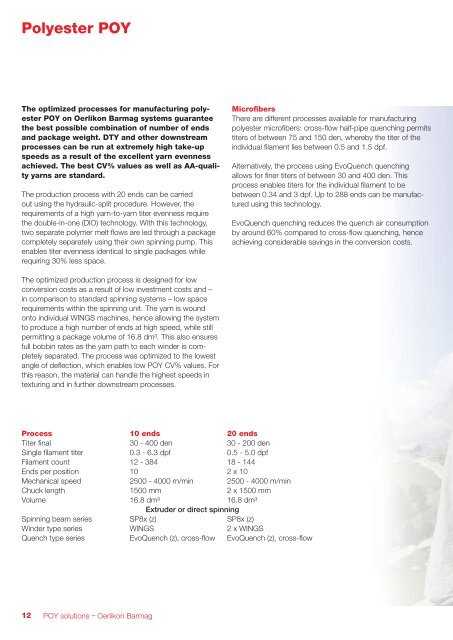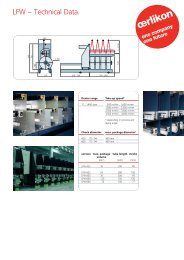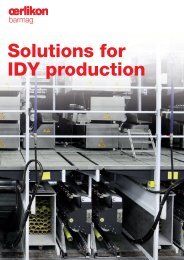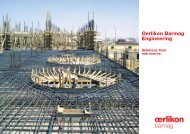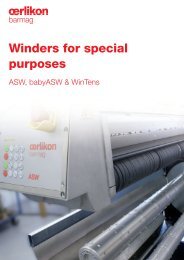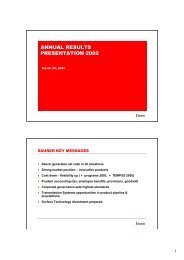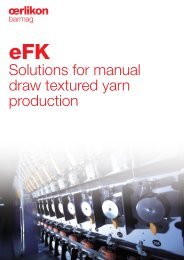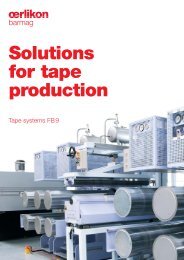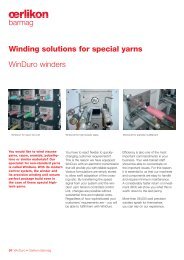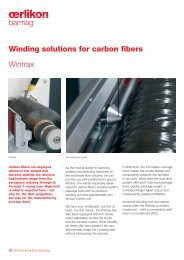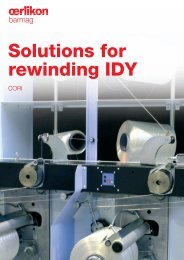Solutions for POY manufacturing - Oerlikon Barmag - Oerlikon Textile
Solutions for POY manufacturing - Oerlikon Barmag - Oerlikon Textile
Solutions for POY manufacturing - Oerlikon Barmag - Oerlikon Textile
Create successful ePaper yourself
Turn your PDF publications into a flip-book with our unique Google optimized e-Paper software.
Polyester <strong>POY</strong><br />
The optimized processes <strong>for</strong> <strong>manufacturing</strong> polyester<br />
<strong>POY</strong> on <strong>Oerlikon</strong> <strong>Barmag</strong> systems guarantee<br />
the best possible combination of number of ends<br />
and package weight. DTY and other downstream<br />
processes can be run at extremely high take-up<br />
speeds as a result of the excellent yarn evenness<br />
achieved. The best CV% values as well as AA-quality<br />
yarns are standard.<br />
The production process with 20 ends can be carried<br />
out using the hydraulic-split procedure. However, the<br />
requirements of a high yarn-to-yarn titer evenness require<br />
the double-in-one (DIO) technology. With this technology,<br />
two separate polymer melt flows are led through a package<br />
completely separately using their own spinning pump. This<br />
enables titer evenness identical to single packages while<br />
requiring 30% less space.<br />
The optimized production process is designed <strong>for</strong> low<br />
conversion costs as a result of low investment costs and –<br />
in comparison to standard spinning systems – low space<br />
requirements within the spinning unit. The yarn is wound<br />
onto individual WINGS machines, hence allowing the system<br />
to produce a high number of ends at high speed, while still<br />
permitting a package volume of 16.8 dm³. This also ensures<br />
full bobbin rates as the yarn path to each winder is completely<br />
separated. The process was optimized to the lowest<br />
angle of deflection, which enables low <strong>POY</strong> CV% values. For<br />
this reason, the material can handle the highest speeds in<br />
texturing and in further downstream processes.<br />
Process 10 ends 20 ends<br />
Titer final 30 - 400 den 30 - 200 den<br />
Single filament titer 0.3 - 6.3 dpf 0.5 - 5.0 dpf<br />
Filament count 12 - 384 18 - 144<br />
Ends per position 10 2 x 10<br />
Mechanical speed 2500 - 4000 m/min 2500 - 4000 m/min<br />
Chuck length 1500 mm 2 x 1500 mm<br />
Volume 16.8 dm³ 16.8 dm³<br />
Extruder or direct spinning<br />
Spinning beam series SP8x (z) SP8x (z)<br />
Winder type series WINGS 2 x WINGS<br />
Quench type series EvoQuench (z), cross-flow EvoQuench (z), cross-flow<br />
12 <strong>POY</strong> solutions – <strong>Oerlikon</strong> <strong>Barmag</strong><br />
Microfibers<br />
There are different processes available <strong>for</strong> <strong>manufacturing</strong><br />
polyester microfibers: cross-flow half-pipe quenching permits<br />
titers of between 75 and 150 den, whereby the titer of the<br />
individual filament lies between 0.5 and 1.5 dpf.<br />
Alternatively, the process using EvoQuench quenching<br />
allows <strong>for</strong> finer titers of between 30 and 400 den. This<br />
process enables titers <strong>for</strong> the individual filament to be<br />
between 0.34 and 3 dpf. Up to 288 ends can be manufactured<br />
using this technology.<br />
EvoQuench quenching reduces the quench air consumption<br />
by around 60% compared to cross-flow quenching, hence<br />
achieving considerable savings in the conversion costs.


